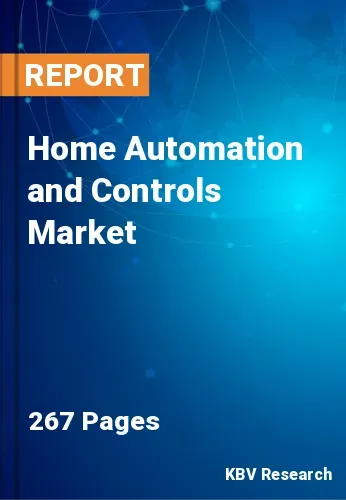The Global Home Automation and Control Market size is expected to reach $106.6 billion by 2028, rising at a market growth of 11.1% CAGR during the forecast period.
The term "home automation system" implies the automatic and electronic management of home activities, features, and appliances. This system has uses in lighting, security, and access control as well as heating, ventilation, and air conditioning. The home automation and controls market is growing as a result of rising demand for smart house lighting systems and the upkeep of secure and safe environments with improved user comfort in various business verticals.
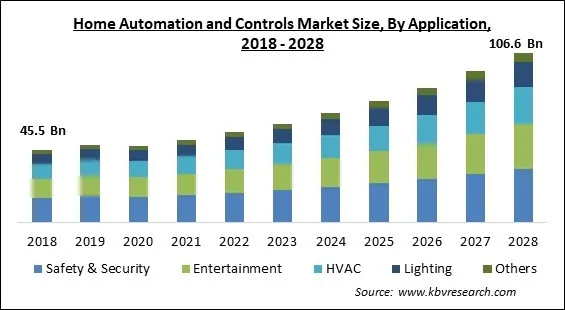
In addition, there is a rise in the use of home automation equipment, widespread wireless technology usage, and government programmes to build smart homes. The development of the home automation and controls industries, however, may be hampered by a lack of compatibility between home control systems.
Moreover, the high rate of urbanization across Asia-Pacific is anticipated to offer potential opportunities for the expansion of the market. Home automation and controls market demand is increasing due to the increase of home automation device deployment, high wireless technology acceptance, demand for energy-efficient technologies, and rise in initiatives by governments to build smart homes. On the other hand, the home automation and controls market is anticipated to benefit greatly from the growing significance of IoT technology.
Due to its considerable effects on key actors in the supply chain, the COVID-19 has had a significant impact on the expansion of the home automation and controls market in 2020. In contrast, the COVID-19 pandemic mostly hurt the market by creating a number of challenges, including project delays or cancellations and a shortage of experienced labourers due to partial or total lockdowns around the world. During the lockup phase of 2020, suppliers of home automation and controls recorded a decline in sales. For example, ABB Ltd. reported a 7% fall in net sales between 2019 and 2020 as a result of lower sales across all operating sectors.
Power line communication is the method of sending data across electrical power lines. It is unnecessary to have different networks for data and power when 110V/240V, 50Hz/60Hz, and data are all transmitted over the same lines. More flexibility and lower installation and retrofitting costs are the results. The rapid proliferation of gadgets and smartphones, as well as technological advancements in power line technology, are driving the development of smart home products that can be operated at the press of a button. Therefore, due to the rapid integration of the power line communication technology in smart homes, the growth of the market is estimated to propel.
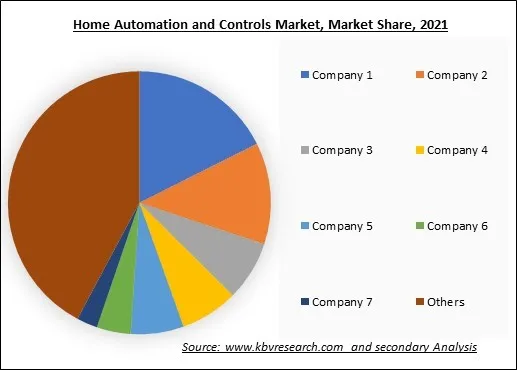
The leading players in the market are competing with diverse innovative offerings to remain competitive in the market. The below illustration shows the percentage of revenue shared by some of the leading companies in the market. The leading players of the market are adopting various strategies in order to cater demand coming from the different industries. The key developmental strategies in the market are Acquisitions.
In recent years, urbanization has been spreading quickly over the world. The process of more people moving into metropolitan areas is known as urbanization. People migrating from rural to urban areas increase the size of urban areas as well as the population there, which is the main driver of urbanization. These demographic fluctuations have also had an impact on other aspects of land use, economic activity, and culture. Throughout history, important changes and advancements in the society and economy have been correlated with urbanization. Therefore, this factor would majorly contribute to the surge in the adoption of smart home automation technology.
Consumers are drawn to the convenience of smart home automation, but it is also fundamentally dangerous. An ecosystem of interconnected gadgets is created through smart home automation, providing users total control over their environment. But every smart device serves as an access point for unauthorized outside actors, just like everything else connected to the internet. These devices, which are becoming more and more common, have the potential to reveal private information and compromise home security. This factor is playing a major role in limiting the growth of the home automation and controls market.
Based on type, the Home Automation and Controls Market is classified into Home Automation System, Mainstream Home Automation System, and Managed Home Automation System. The home automation system segment generated the major revenue share in 2021. Home automation which can be understood as a combination of hardware, electronic interfaces, and communication, connects commonplace devices to each other over the Internet. Whether at home or thousands of miles away, an individual can control each gadget from your smartphone or tablet because they all have sensors and Wi-Fi connectivity.
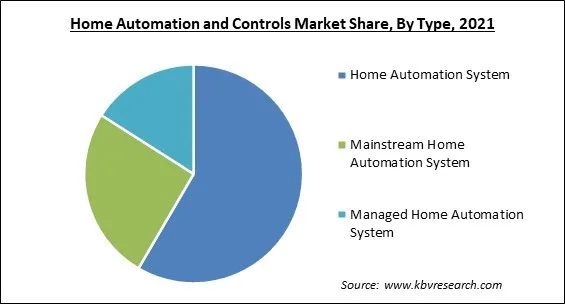
Based on technology, the home automation and controls market is categorized into Wired Home Automation Systems, Wireless Home Automation Systems, Powerline Home Automation Systems, and Computing Network Home Automation Systems. The Wireless Home Automation System market represented the significant revenue share in 2021. This is related to the increase in adoption of wireless home automation systems and their ease of installation and use. Additionally, Wireless home automation with IoT is a cutting-edge internet of things application created to remotely operate home appliances through the cloud.
Based on application, the market is classified into Lighting, HVAC, Entertainment, Safety & Security, and Others. The lighting segment is expected to experience a strong growth rate throughout the forecast period. Automated lighting management, including programmed dimming and on/off control, can dramatically change both a home's interior and a family's way of life. Such systems are no longer just for expensive homes because to their falling costs and complexity.
| Report Attribute | Details |
|---|---|
| Market size value in 2021 | USD 51.8 Billion |
| Market size forecast in 2028 | USD 106.6 Billion |
| Base Year | 2021 |
| Historical Period | 2018 to 2020 |
| Forecast Period | 2022 to 2028 |
| Revenue Growth Rate | CAGR of 11.1% from 2022 to 2028 |
| Number of Pages | 269 |
| Number of Tables | 383 |
| Report coverage | Market Trends, Revenue Estimation and Forecast, Segmentation Analysis, Regional and Country Breakdown, Market Share Analysis, Competitive Landscape, Companies Strategic Developments, Company Profiling |
| Segments covered | Application, Type, Technology, Region |
| Country scope | US, Canada, Mexico, Germany, UK, France, Russia, Spain, Italy, China, Japan, India, South Korea, Singapore, Malaysia, Brazil, Argentina, UAE, Saudi Arabia, South Africa, Nigeria |
| Growth Drivers |
|
| Restraints |
|
Based on Region, the Home Automation and Controls Market is categorized into North America, Europe, Asia Pacific, and LAMEA. In 2021, North America contributed the largest revenue share of the home automation and controls market. A huge consumer base along with prominent manufacturers within the region are complementing the growth of the regional market. Moreover, various regional countries, like the United States, are early adopters of advanced and cutting-edge technologies.
Free Valuable Insights: Global Home Automation and Controls Market size to reach USD 106.6 Billion by 2028
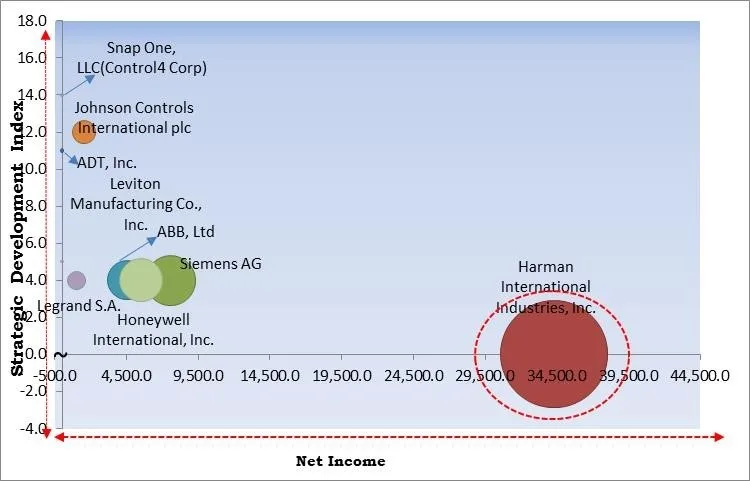
The major strategies followed by the market participants are Acquisitions. Based on the Analysis presented in the Cardinal matrix; Harman International Industries, Inc., is the forerunners in the Home Automation and Controls Market. Companies such as Siemens AG, Honeywell International, Inc., and ABB Ltd. are some of the key innovators in Home Automation and Controls Market.
The market research report covers the analysis of key stake holders of the market. Key companies profiled in the report include Siemens AG, Honeywell International, Inc., ABB Group, Johnson Controls International PLC, Harman International Industries, Inc. (Samsung Electronics Co., Ltd.), Snap One Holdings Corp. (Control4), Legrand Group, ADT Inc., Nice S.p.A., and Leviton Manufacturing Co., Inc.
By Application
By Type
By Technology
By Geography


The global Home Automation and Controls Market size is expected to reach $106.6 billion by 2028.
Plc Technology In Smart Homes are driving the market in coming years, however, The Risk Of Unauthorized Access To The Automation System restraints the growth of the market.
Siemens AG, Honeywell International, Inc., ABB Group, Johnson Controls International PLC, Harman International Industries, Inc. (Samsung Electronics Co., Ltd.), Snap One Holdings Corp. (Control4), Legrand Group, ADT Inc., Nice S.p.A., and Leviton Manufacturing Co., Inc.
The Safety & Security segment is leading the Global Home Automation and Controls Market by Application in 2021 thereby, achieving a market value of $33.9 billion by 2028.
The Europe market dominated the Global Home Automation and Controls Market by Region in 2021, and would continue to be a dominant market till 2028; thereby, achieving a market value of $35.3 billion by 2028.
Our team of dedicated experts can provide you with attractive expansion opportunities for your business.
